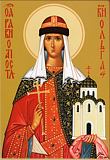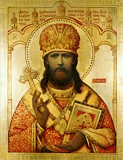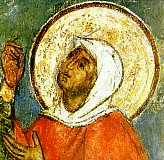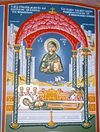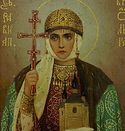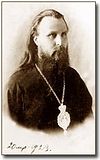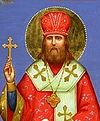

| Previous day | Next day |
| Old Style
July 11
|
Wednesday |
New Style
July 24
|
|
6th Week after Pentecost.
Tone 4.
Fast Day. |
Wine and oil allowed.
|
![]() Commemoration of the Miracle of Great-martyr Euphemia the All-praised, of Chalcedon (451).
Commemoration of the Miracle of Great-martyr Euphemia the All-praised, of Chalcedon (451). ![]() Blessed Equal-to-the-Apostles Olga, princess of Russia, named Helen in holy baptism (969).
Blessed Equal-to-the-Apostles Olga, princess of Russia, named Helen in holy baptism (969). ![]() Uncovering of the relics of Hieromartyr Hilarion, archbishop of Verey (1998).
Uncovering of the relics of Hieromartyr Hilarion, archbishop of Verey (1998).
Hieromartyr Cindeus, priest, of Pamphylia (283-305). St. Arcadius, monk, of Vyazma (ca. 1592).
Martyrs Januarius and Pelagia, of Nicopolis in Armenia (ca. 310). St. Drostan of Old Deer and Aberdeen (Scotland) (6th c.). St. Nicodemus of Hilandar and Vatopedi, Mt. Athos, instructor of St. Gregory Palamas (1320). New Martyr Nicodemus of Elbasan and Mt. Athos (1722). New Monk-martyr Nectarius of St. Anne’s Skete, Mt. Athos, at Vryoulla, Ephesus (1820). St. Cyril, monk, of Paros (1833). New Hieromartyrs Momcilo Grgurevic, Dobroslav Blazenovic, Milan Bozic, Mihailo Djusic, Jovan Zecevic, Bozidar Jovic, Bogdan Lalic, Trifun Maksimovic, Velimir Mijatovic, Bozidar Minic, Miladin Minic, Marko Popovic, Dimitrije Rajanovic, Budimir Sokolovic, Relja Spahic, Lazar Culibrk, Savo Siljac, Savo Skaljka, Milorad Vukojicic, Ratomir Jankovic, Mihailo Jevdjevic, Dusan Prijovic, Dobrosav Sokovic, Nestor Trkulja, Serafim Dzaric, Andrija Siljak, Slobodan Siljak, and Jovan Rapajic, priests, of Serbia (1941-1945). St. Leo, monk, of Mandra.
Repose of cave-dweller Anastasia of St. Cornelius of Padan Hermitage in Olonets (1901).
Thoughts for Each Day of the Year
According to the Daily Church Readings from the Word of God
By St. Theophan the Recluse

Wednesday. [I Cor. 2:9-3:8; Matt. 13:31-36]
The kingdom is like a grain of mustard seed and leaven. A small grain of mustard seed grows up into a big bush; leaven penetrates the whole lump of dough and makes it leavened. Here, on the one hand, is an image for the Church, which in the beginning consisted only of the apostles and several other people, then spread and became most numerous, penetrating all of humanity; on the other hand, it is an image of the spiritual life revealed in every person. Its first seed is the intention and determination to be saved through pleasing God, upon faith in the Lord and Saviour. This determination, no matter how firm, is like a tiny dot. In the beginning it embraces only one’s consciousness and activities; then from this all of the activity of a spiritual life develops. Its movement and strength multiply and mature within its own self, and it begins to penetrate all the powers of the soul—the mind, will, feelings, then fills them with itself, makes them leavened according to its spirit, and penetrates the entire constitution of the human nature, body, soul, and spirit in which it was engendered.
Articles
 Venerable Arcadius of NovotorskSaint Arcadius of Vyazma and Novotorsk was from the city of Vyazma of pious parents, who from childhood taught him prayer and obedience. |
